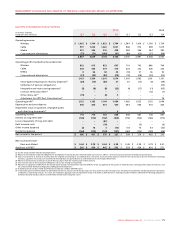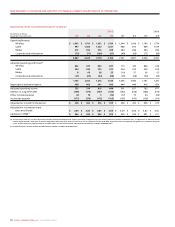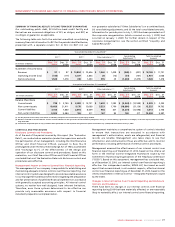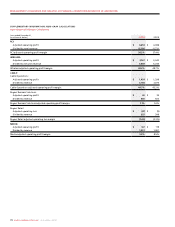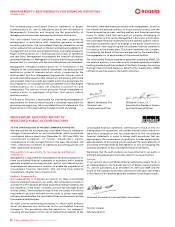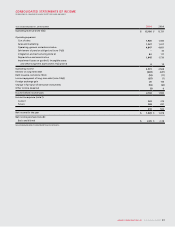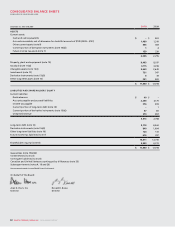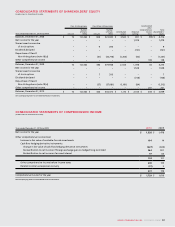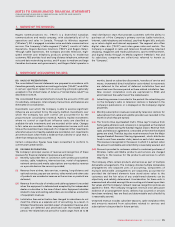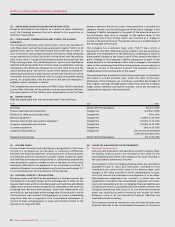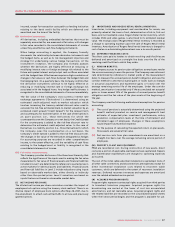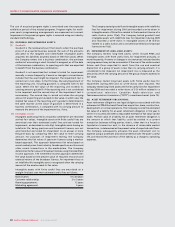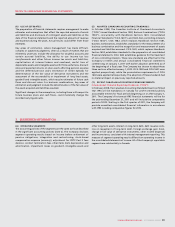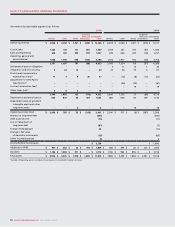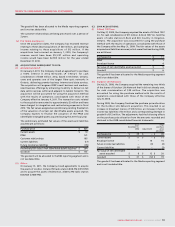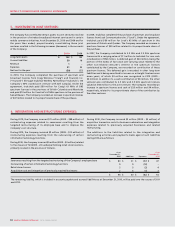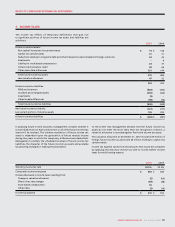Rogers 2010 Annual Report Download - page 81
Download and view the complete annual report
Please find page 81 of the 2010 Rogers annual report below. You can navigate through the pages in the report by either clicking on the pages listed below, or by using the keyword search tool below to find specific information within the annual report.
ROGERS COMMUNICATIONS INC. 2010 ANNUAL REPORT 85
Rogers Communications Inc. (“RCI”) is a diversified Canadian
communications and media company, with substantially all of its
operations and sales in Canada. Through its Wireless segment
(“Wireless”), RCI is engaged in wireless voice and data communications
services. The Company’s Cable segment (“Cable”) consists of Cable
Operations, Rogers Business Solutions (“RBS”) and Rogers Retail.
Through Cable Operations, the Company provides television, high-
speed Internet and telephony products primarily to residential
customers; RBS provides local and long-distance telephone, enhanced
voice and data networking services, and IP access to medium and large
Canadian businesses and governments; and Rogers Retail operates a
retail distribution chain that provides customers with the ability to
purchase all of the Company’s primary services (cable television,
Internet, cable telephony and wireless), pay their Rogers bills, and pick
up or return digital and Internet equipment. The segment also offers
digital video disc (“DVD”) and video game sales and rentals. The
Company is engaged in radio and television broadcasting, televised
shopping, magazines and trade publications, sports entertainment,
and digital media through its Media segment (“Media”). RCI and
its subsidiary companies are collectively referred to herein as
the “Company”.
(A) BASIS OF PRESENTATION:
The consolidated financial statements are prepared in accordance with
Canadian generally accepted accounting principles (“GAAP”) and differ
in certain significant respects from accounting principles generally
accepted in the United States of America (“United States GAAP”) as
described in note 25.
The consolidated financial statements include the accounts of RCI and
its subsidiary companies. Intercompany transactions and balances are
eliminated on consolidation.
Investments over which the Company is able to exercise significant
influence are accounted for by the equity method. Investments over
which the Company has joint control are accounted for by the
proportionate consolidation method. Publicly traded investments
where no control or significant influence exists are classified as
available-for-sale investments and are recorded at fair value. Changes
in fair value are recorded in other comprehensive income until such
time as the investments are disposed of or impaired. Other investments
where fair value is not readily available are recorded at cost. Investments
are written down when there is evidence that a decline in value that is
other than temporary has occurred.
Certain comparative figures have been reclassified to conform to
current year’s presentation.
(B) REVENUE RECOGNITION:
The Company’s principal sources of revenue and recognition of these
revenues for financial statement purposes are as follows:
(i) Monthly subscriber fees in connection with wireless and wireline
services, cable, telephony, Internet services, rental of equipment,
network services and media subscriptions are recorded as revenue
on a pro rata basis as the service is provided;
(ii) Revenue from airtime, data services, roaming, long-distance and
optional services, pay-per-use services, video rentals and other sales
of products are recorded as revenue as the services or products are
delivered;
(iii) Revenue from the sale of wireless and cable equipment is recorded
when the equipment is delivered and accepted by the independent
dealer or subscriber in the case of direct sales. Equipment subsidies
related to new and existing subscribers are recorded as a reduction
of equipment revenues;
(iv) Installation fees and activation fees charged to subscribers do not
meet the criteria as a separate unit of accounting. As a result, in
Wireless these fees are recorded as part of equipment revenue and,
in Cable, are deferred and amortized over the related service
period. The related service period for Cable ranges from 26 to 48
months, based on subscriber disconnects, transfers of service and
moves. Incremental direct installation costs related to reconnects
are deferred to the extent of deferred installation fees and
amortized over the same period as these related installation fees.
New connect installation costs are capitalized to PP&E and
amortized over the useful lives of the related assets;
(v) Advertising revenue is recorded in the periods the advertising airs
on the Company’s radio or television stations; is featured in the
Company’s publications; or is displayed on the Company’s digital
properties;
(vi) Monthly subscription revenues received by television stations for
subscriptions from cable and satellite providers are recorded in the
month in which they are earned;
(vii) The Toronto Blue Jays Baseball Club’s (“Blue Jays”) revenue from
home game admission and concessions is recognized as the related
games are played during the baseball regular season. Revenue from
radio and television agreements is recorded at the time the related
games are aired. The Blue Jays also receive revenue from the Major
League Baseball Revenue Sharing Agreement, which distributes
funds to and from member clubs, based on each club’s revenues.
This revenue is recognized in the season in which it is earned, when
the amount is estimable and collectibility is reasonably assured; and
(viii) Discounts provided to customers related to combined purchases of
Wireless, Cable and Media products and services are charged
directly to the revenue for the products and services to which
they relate.
The Company offers certain products and services as part of multiple
deliverable arrangements. The Company divides multiple deliverable
arrangements into separate units of accounting. Components of
multiple deliverable arrangements are separately accounted for
provided the delivered elements have stand-alone value to the
customers and the fair value of any undelivered elements can be
objectively and reliably determined. Consideration for these units is
measured and allocated amongst the accounting units based upon their
fair values and the Company’s relevant revenue recognition policies are
applied to them. The Company recognizes revenue once persuasive
evidence of an arrangement exists, delivery has occurred or services
have been rendered, fees are fixed and determinable and collectibility
is reasonably assured.
Unearned revenue includes subscriber deposits, cable installation fees
and amounts received from subscribers related to services and
subscriptions to be provided in future periods.
1. NATURE OF THE BUSINESS:
2. SIGNIFICANT ACCOUNTING POLICIES:
NOTES TO CONSOLIDATED FINANCIAL STATEMENTS
(TABULAR AMOUNTS IN MILLIONS OF CANADIAN DOLLARS, EXCEPT PER SHARE AMOUNTS)
YEARS ENDED DECEMBER 31, 2010 AND 2009


